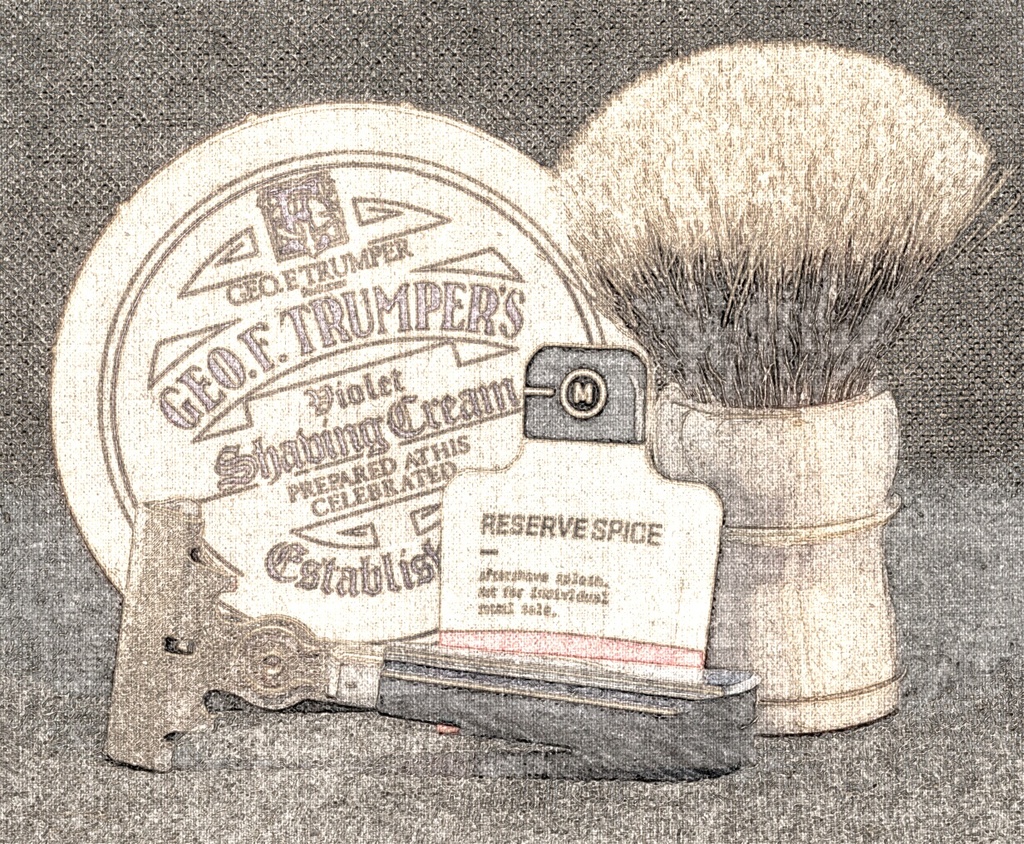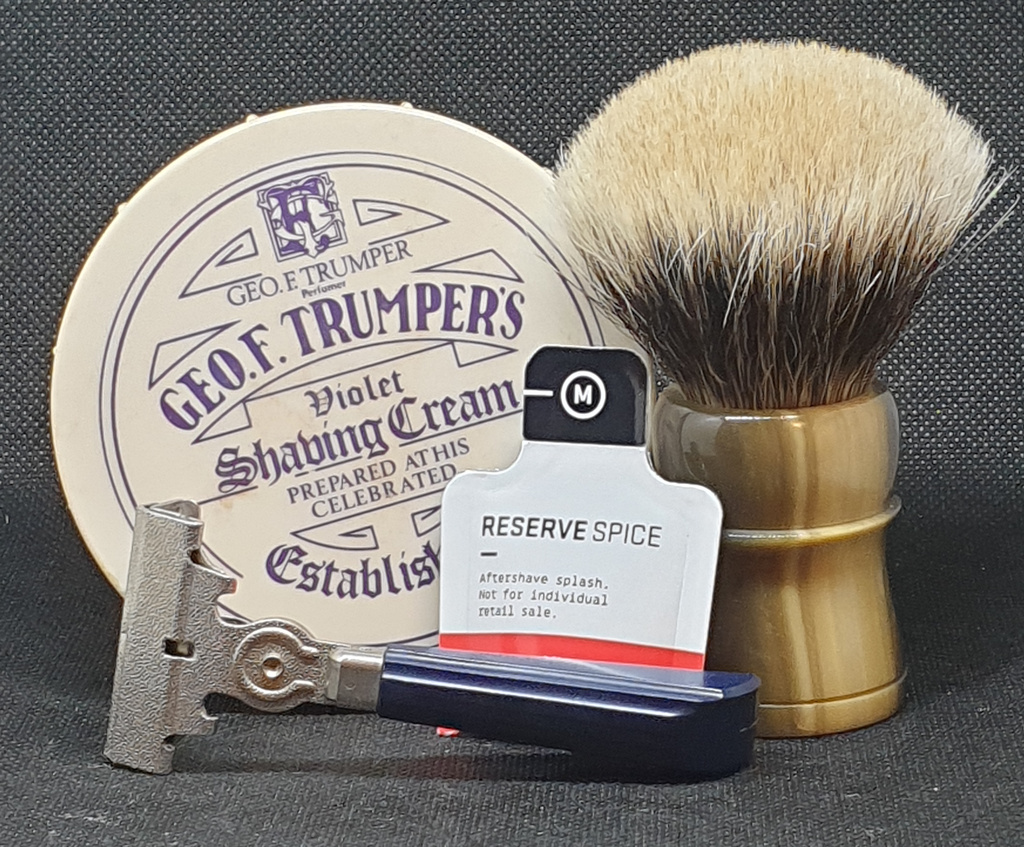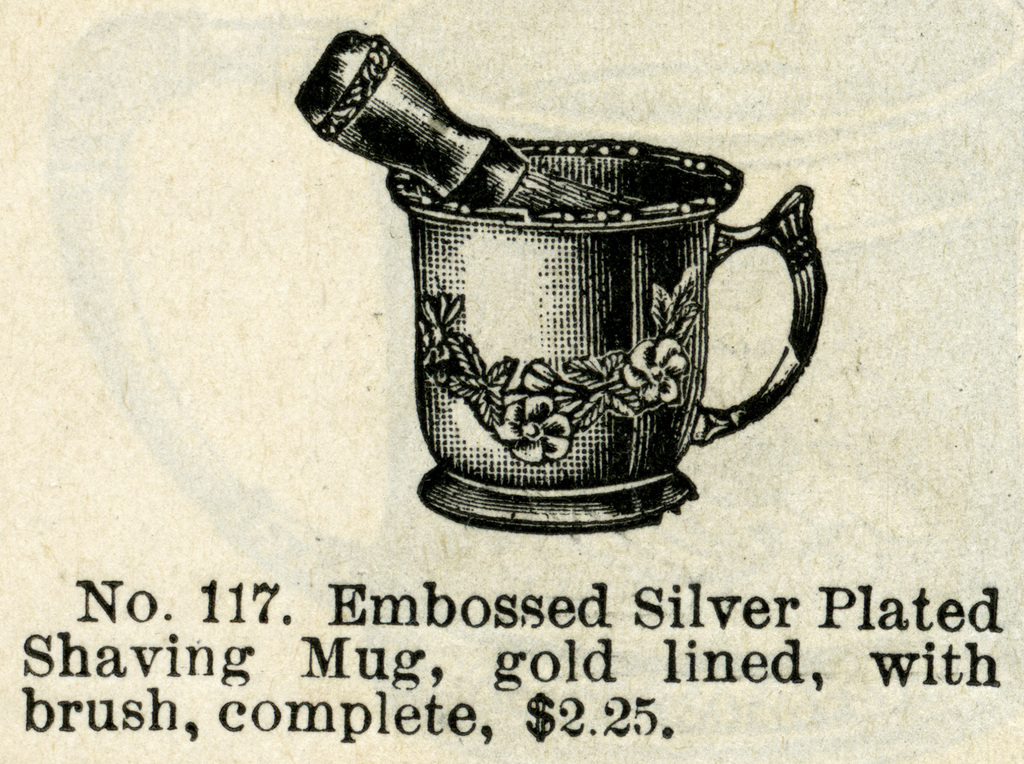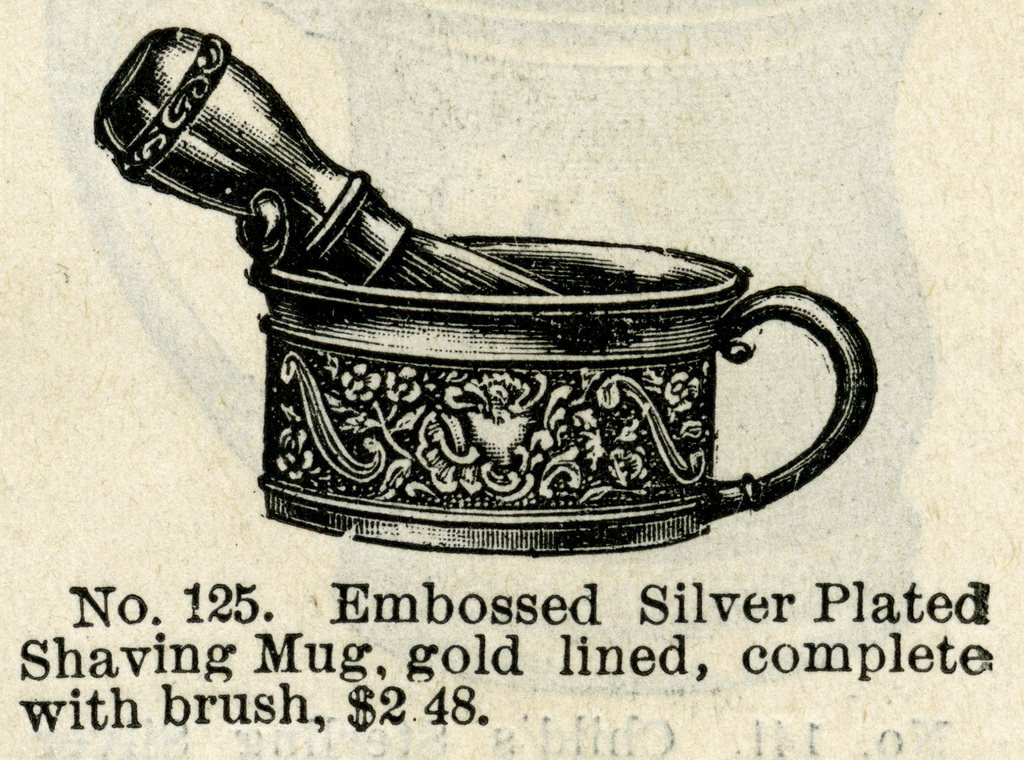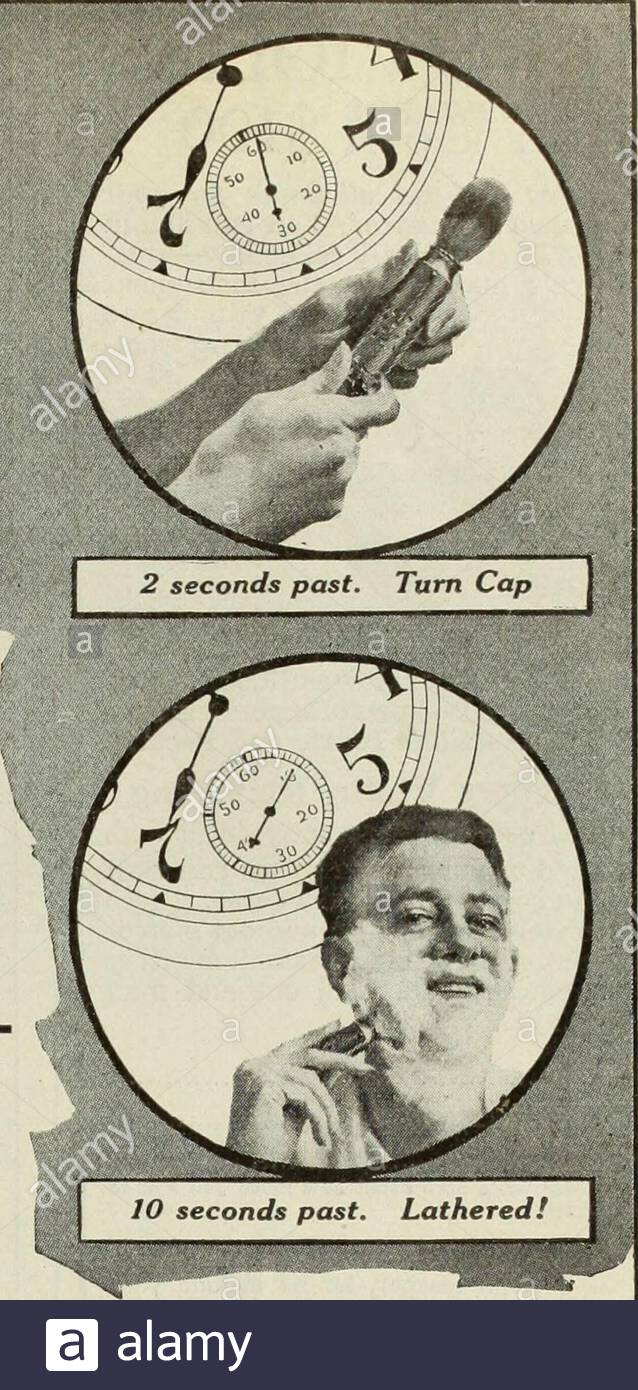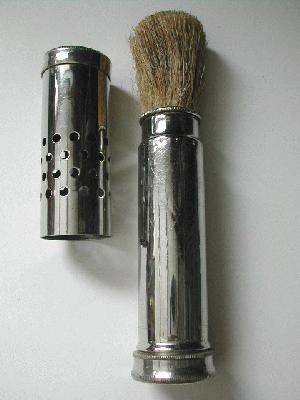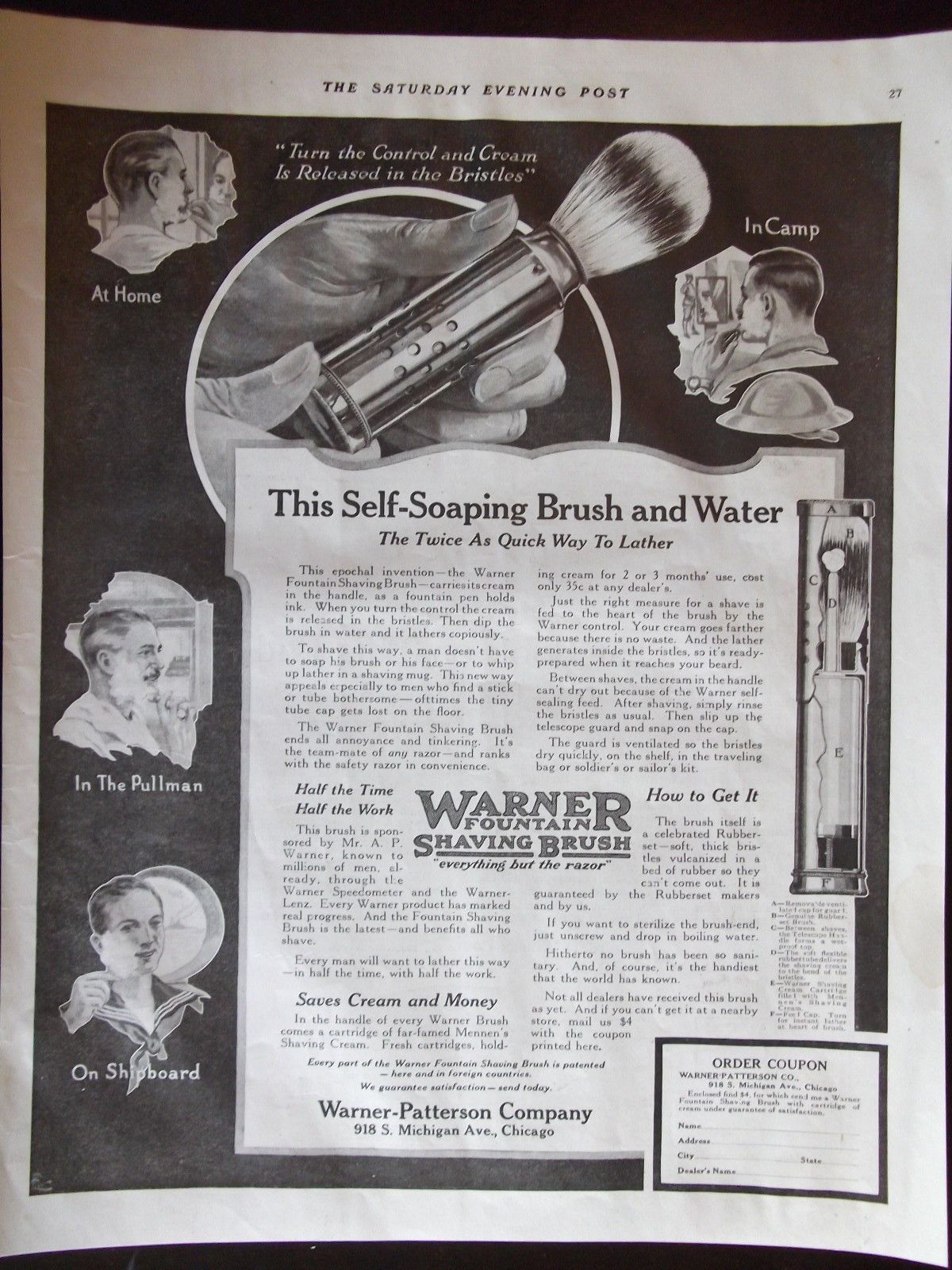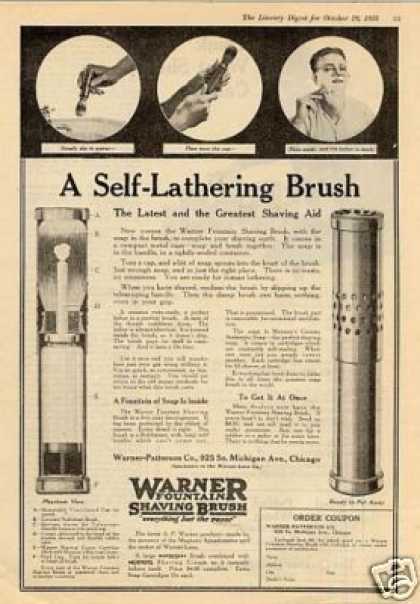Razor: Shick G4
Blade: Schick Injector
Brush: Artesania Romera Manchurian Badger, imitation horn
Lather: Geo F Trumer’s Violet Shaving Cream
Aftershave: Sample
Additional Care: Alum Block
Tag Archives: ShavingBrush
Shave of the day 17th July
Razor: Shick G4
Blade: Schick Injector
Brush: Brush Experimental Alpha
Lather: Dalane d’men Energenic
Aftershave: BullDog Sensitive Aftershave Balm
Additional Care: Alum Block
Shave of the day 15th July
Razor: Shick G4
Blade: Schick Injector
Brush: Brush Experimental Alpha
Lather: Palmolive Sensitive w/ aloe vera
Aftershave: Sample
Additional Care: Alum Block
Really fancy shave gear
How about a gold lined shave brush and mug in embossed silver plate? Yours for just 2.48$ – in 1897, that was… so according to inflation calculators it would be a mere 80$ or so today.
Too much? How about 2.25$ then, for one with somewhat less embossing? No? They are very fancy…
Both were listed in the Hugh O’Neill & Co. 1897-98 Fall and Winter Catalogue – Hugh O’Neill being – in effect – a multichannel merchant. The company had a huge department store in New York, as well as shipping out about a quarter million catalogues every year. In many ways a competitor to the more well known Sears Catalogue, it’s not surprising that they were showcasing shaving gear.
I’m not entirely convinced they were rugged enough to survive in any great number until today – the silver plating and gold lining were probably as thin as they could possible make it, to save on valuable resources. And when the fashion turned against the embossed designs, they likely got discarded or used for less glamorous needs.
Warner Self-Soaping Brush
This epochal invention – the Warner Fountain Shaving Brush – carries it’s cream in the handle, as a a fountain pen holds ink. When you turn the control the cream is released in the bristles. Then dip the brush in water and it lathers copiously.
Some poor copywriter, 1918
To shave this way, a man doesn’t have to soap his brush or his face – or to whip up lather in a shaving mug. This new way appeals espesially to men who find a stick or tube bothersome – ofttimes the tiny tube cap gets lost on the floor.
The Warner Fountain Shaving Brush ends all annoyance and tinkering. It’s the team-mate of any razor – and ranks with the safety razor in convenience.
The self-lathering – or self feeding – shaving brush is an idea that keeps popping up again and again.. I’ve earlier touched upon a self feeding shaving brush from 1849, another self-feeding shaving brush from 1907, a shaving brush suitable for travel from 1922, a soap-dispensing shaving brush from 1929, a fountain shaving brush from 1931, as well as a trio of shaving brushes for use with canned foam. While the brush sponsored by Mr A. P. Walter – known to million s of men, already, through the Warner Speedometer and the Warner Lenz – is a fairly standard as far as fountain brushes goes, it does use cartridges of cream, freeing the shaver of the chore of manually filling the handle with cream.
Speaking of the cream; Warner apparently teamed up with the manufacturer of the far-famed Mennen’s Shaving Cream – fresh cartridges with enough cream for two to three months of shaving available at any dealer for a mere 35 cents.
According to the advertisements, the knot itself was a celebrated Rubberset brush – soft and thick bristles set in a bed of vulcanised rubber, guarantied by both the Rubberset makers and by Warner. The knot was detachable and easily sterilised (just “…drop in boiling water”), and the nozzle that delivered the cream into the knot was self sealing to prevent the cream from drying out.
Enough of Warner’s Fountain Brushes must have been sold for the brush to show up on online auctions sites from time to time… but given how pristine the boxes sometimes looks I’m not convinced they saw a lot of use – possible it was better as a Father Day gift when you were out of ideas than an actual daily driver in the bathroom?
Shave of the day 20th May
Razor: Tatara Masamune
Blade: Wilkinson Sword
Brush: Brush Experimental Alpha
Lather: Mike’s Natural Soaps Orange, Cedarwood & Black Pepper
Aftershave: BullDog Sensitive Aftershave Balm
Additional Care: Alum Block & BullDog Original Beard Oil
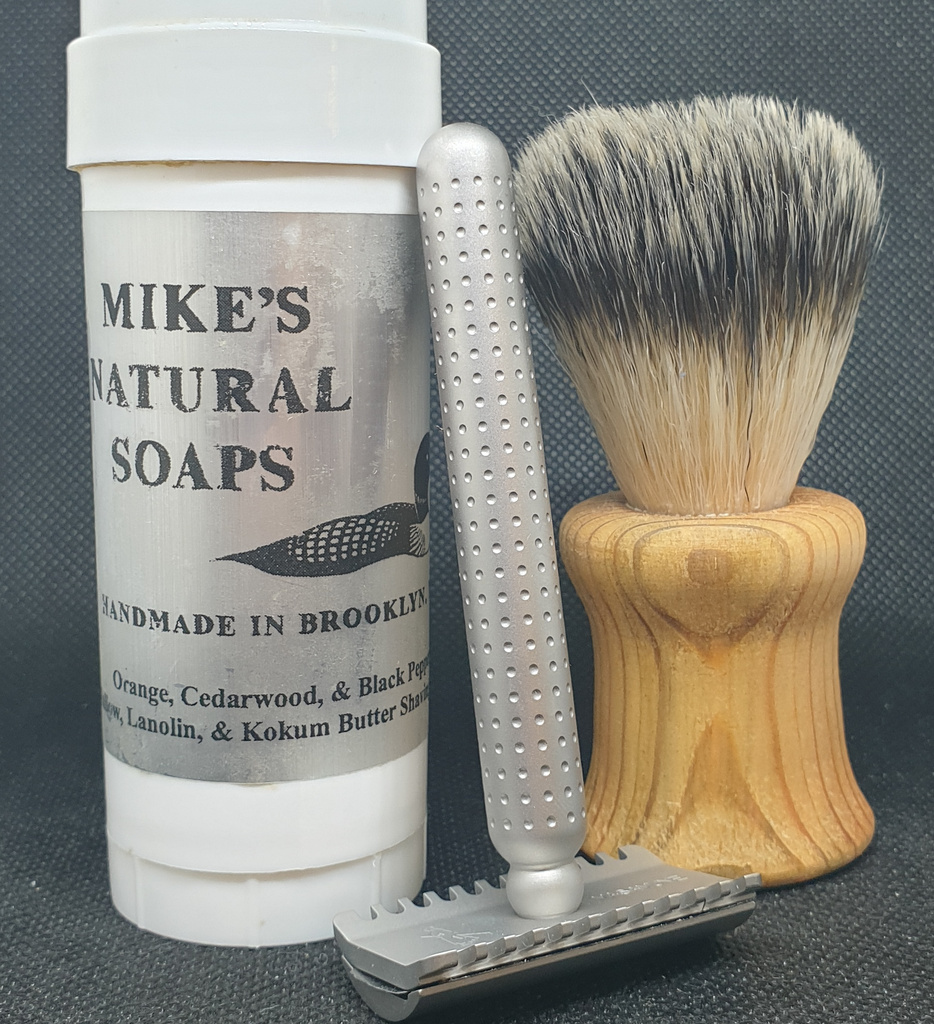
Gronbech’s shaving brush suitable for travel and home
Today’s patent isn’t all that unique, apart from being invented by the same gentleman whom patented the travel razor I looked at last Thursday. It is one of the recurring self-feeding or fountain shaving brushes – of which I’ve snarked on several before1 – and the claimed improvement was in the way it was made.
The principal object of the invention is to provide a simply constructed and efficiently operating device, which is sanitary in use, sightly in appearance and may be economical manufactured.
Christian E A Gronbech, US 1,1409,168
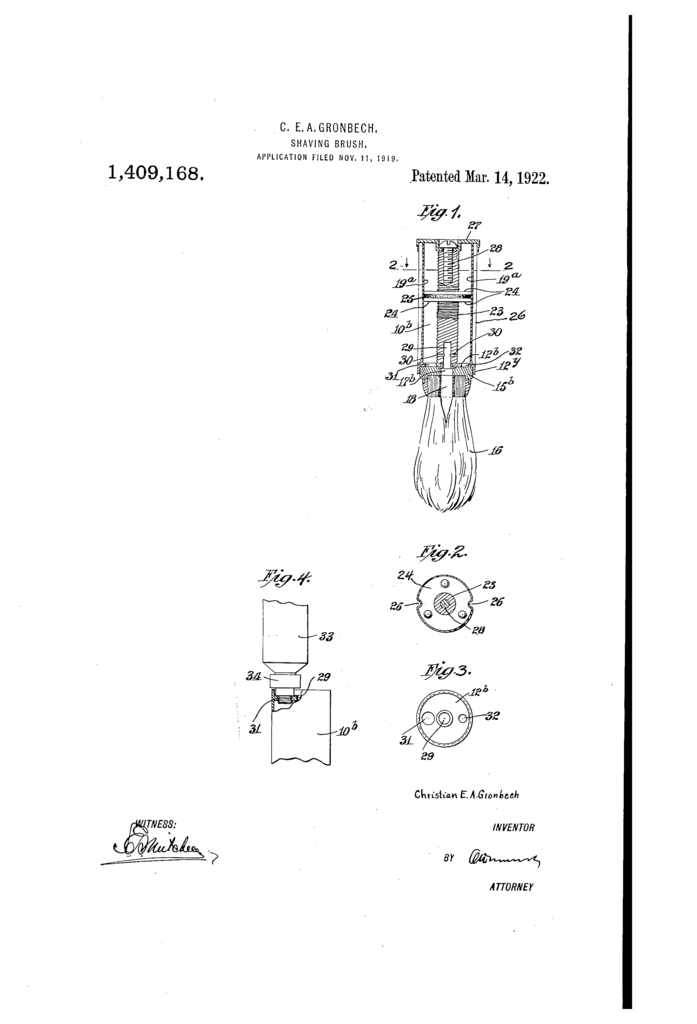
As can be seen from the drawing, the handle of the brush is hollow, with a threaded rod down the centre. The cap on the base of the handle is secured to the rod by means of a screw – allowing the rod to be turned – and a plunger or piston rides on the rod. A pair of longitudinal indentation – or ridges, if you prefer – is pressed into the sides of the handle (refer to figure 2 on the drawing) for the plunger to ride on as it’s screwed up and down.
The plunger itself is a sandwiched construction, consisting of two disks with a washer between them. While the patent text don’t specify, I suspect that the two disks (24) was meant to be metal while the washer was made of rubber – thus creating a seal against the sidewalls of the handle.
The knot sits in a base (15) which is secured to the handle by means of screw threads (12y), and can be removed by the user – has to be removed in fact, in order to refill soap paste. The base has a hole in the middle to allow soap paste to enter the brush.
As the cap is turned and the plunger pushes towards the knot, the soap paste in the handle is forced past openings (ducts and an axial bore) in the rod and into the knot, allowing the user to lather up and get shaving.
When the handle is empty of the soap paste, the user is meant to unscrew the knot, move the plunger all the way to the back of the handle by means of the cap, and refill the handle from a small tube screwed into a threaded hole under the knot – an air hole allowed for the air in the handle to be expelled during this operation.
Looking at the drawing, it’s obvious that most of the parts can be constructed by stamping sheet metal and off the shelf pieces (like the screw rod and screw), allowing for fast, inexpensive manufacture with minimal machining. The handle can even be a length of extruded aluminium if someone wants to make this today, and it don’t even have to be round as long as the plunger is a tight fit (if it’s not round you wouldn’t necessarily need the pair of ridges either).
Patented at about the same time as his handleless travel razors, Gronbech’s self feeding brush would have made a nice addition to the dopp bag since it would have done away with the need to carry a tube of soap separably. However it does suffer from the same fault as all self feeding shaving brushes I’ve seen so far; the soap is introduced to the base of the knot, not towards the tips where the lather is actually built.
- See for example “A 1849 self feeding shaving brush!“, “Soap-dispensing shaving brush“, and “Fountain shaving brush“.
A collapsible lather brush
The desire to improve and enhance upon things must be as old as the drive to invent in the first place, and the brush that Mr Marcus B Berhman filed a patent for in 1919 is in fact a useful improvement on the classic brush – if only for travel purposes.
…a lather brush compromising a handle and bristles, the knot of the bristles being held by suitable inner and outer ferrules and the bristles being adapted to be concealed within the handle of the brush or exposed outwardly therefrom for use, said handle being in hinged together sections adapted to be opened outwardly to receive the bristles or to permit the same to be removed from the handle, and said outer ferrule being adapted to lock the handle in closed position, both when the bristles are within the handle and when said bristles are in exposed condition.
Makes me dizzy just to read all that.. but the long and the short is that the handle is hollow, hinged, and shaped to hold the knot when in the stowed position. Luckily the drawing that accompanies the patent is clearer than the text when it comes to explaining things.
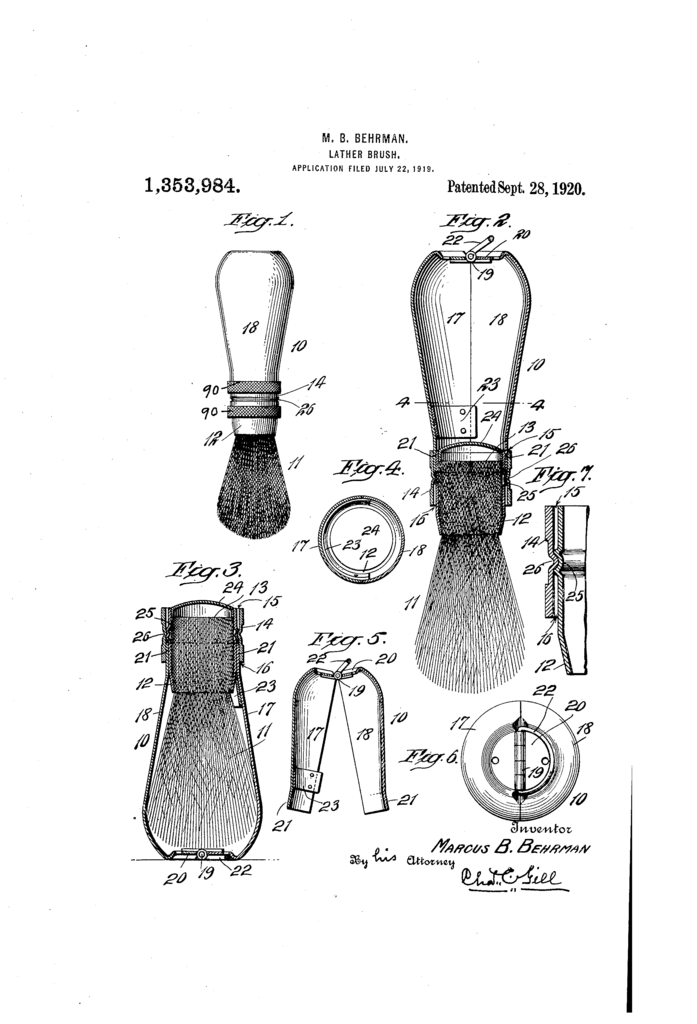
Looks like a handy travel brush, and one I wouldn’t mind having. I do like the fact that when folded it takes half the space, meaning you can more easily fit a full sized brush in your dopp bag. While the original idea likely was to make it out of stamped sheet metal, there is no reason why a modern recreation of this idea can’t use different materials that stands up to the damp a bit better.
Shave of the day 25th March
Razor: Merkur (?) NOS Bakelite Slant
Blade: Feather Hi-Stainless
Brush: Brush Experimental Alpha
Lather: GzD Shavestick
Aftershave: BullDog Sensitive Aftershave Balm
Additional Care: Alum Block

